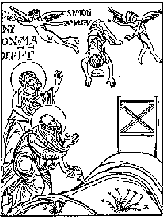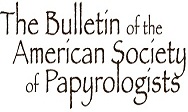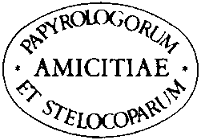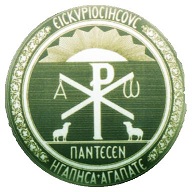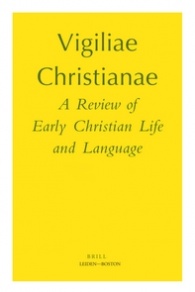The Ancoratus was written by Epiphanius of Salamis in 374, in order to oppose the theologies of Origen and Arius.[1] In this inluential dogmatic work, Epiphanius argued that salvation belongs to the Christians “anchored” in the Apostolic tradition of the Church, far from the bubbling waters of the heretical doctrines.
Epiphanius of Salamis was one of the principal saints of the Coptic Church, and his work, the Ancoratus, appears in several Sahidic manuscripts. According to some scholars, the translation was made at an early date by Pachomian monks in order to defend the Orthodox viewpoint against the Origenist current.[2] Although this possibility might be true, there is insufficient evidence to support it.
In this post, I will briefly introduce a newly identified fragment from the Coptic version of Ancoratus.[3] This fragment was formerly part of the Charles Woide collection in the Clarendon Press, Oxford, but is currently kept in the Bodleian Library as “Clarendon Press b.4, f. 63” (olim 82). The leaf is paginated 105-106 and was dismembered from a parchment codex copied in two columns.
A comparison with the Greek text shows that the Oxford witness contains the text of Ancoratus 50,5-52,1 according to Holl’s edition. Like all other Sahidic manuscripts in the Woide collection, the fragment came from the library of the White Monastery, situated in Upper Egypt. The paleographical features enable us to attribute the new bit to a codex from which numerous other leaves have been identified in the past century. In the CMCL database, a scholarly enterprise which tries to reconstruct the dismembered White Monastery manuscripts, this codex is designated under the siglum MONB.HA.
 The first fragments of this codex containing the Ancoratus were published by Johannes Leipoldt in the beginning of the 20th century.[4] A significant amount of supplementary fragments was discovered and presented by Enzo Lucchesi in an article published in Analecta Bollandiana.[5] Lucchesi first observed that, although the format and general appearance of the White Monastery fragments of the Ancoratus are alike, the paleographical features suggest that they were copied by two different scribes and must have been derived from two codices. In her turn, Alla Elanskaya announced a supplementary folio from the Pushkin Museum in Moscow, which was for a long time unavailable to the scholars living on the Western side of the Iron Curtain.[6] In 1995, Alberto Camplani identified a previously unknown fragment from the Pierpont Morgan Library, New York.[7] The article of Camplani is still the most useful guide for the Coptic version of Ancoratus. Finally, Delio Vanio Proverbio mentioned two new folios in the National Library in Naples and one in Cambridge University Library.[8] The identity of the fragments was revealed to him by Enzo Lucchesi, the tireless scholar of Coptic manuscripts.
The first fragments of this codex containing the Ancoratus were published by Johannes Leipoldt in the beginning of the 20th century.[4] A significant amount of supplementary fragments was discovered and presented by Enzo Lucchesi in an article published in Analecta Bollandiana.[5] Lucchesi first observed that, although the format and general appearance of the White Monastery fragments of the Ancoratus are alike, the paleographical features suggest that they were copied by two different scribes and must have been derived from two codices. In her turn, Alla Elanskaya announced a supplementary folio from the Pushkin Museum in Moscow, which was for a long time unavailable to the scholars living on the Western side of the Iron Curtain.[6] In 1995, Alberto Camplani identified a previously unknown fragment from the Pierpont Morgan Library, New York.[7] The article of Camplani is still the most useful guide for the Coptic version of Ancoratus. Finally, Delio Vanio Proverbio mentioned two new folios in the National Library in Naples and one in Cambridge University Library.[8] The identity of the fragments was revealed to him by Enzo Lucchesi, the tireless scholar of Coptic manuscripts.
The Oxford fragment identified here falls in the lacuna between New York, Pierpont Morgan Morgan M706b (paginated 93-94) and London, British Museum Or. 3581A, f. 153 (paginated 115-116). Here is the inventory of MONB.HA with its parallels according to Holl’s edition of the Greek text:
Cairo Coptic Museum 9287 (p. xxx-xxx) = chap. 15,2-8[9]
Paris BN 1313, ff. 19-21 (p. 65-70) = chap. 29,7-32,7
Paris BN 1313, ff. 22-24 (p. 75-80) = chap. 34,3-37,2
New York Pierpont Morgan M706b (p. 93-94) = chap. 43,6-44,4[10]
Clarendon Press b.4, f. 63 (p. 105-106) = chap. 50,5-52,1
London BL Or. 3581A, f. 153 (p. 115-116) = chap. 55,7-56,4[11]
Cambridge CUL Or. 1699 L (beginning of the 10th quire) = chap. 65,1-8[12]
London BL Or. 3581A, f. 142 (p. 193-194) = chap. 95,1-96,3[13]
Naples IB.14, f. 41 (p. 195-196) = chap. 96,5-97,7
Naples IB.14, f. 42 (p. 199-200) = chap. 98,7-99,4
Paris BN 1303, ff. 55-58 (p. 211-218) = chap. 104,6-108,1
Paris BN 1313, f. 18 (p. 219-220) = chap. 108,1-109,2
[1] Critical edition of the Greek text in K. Holl, Epiphanius I. Ancoratus und Panarion haer. 1-33 (GCS, 25; Leipzig 1915).
[2] J.F. Dechow, Dogma and Mysticism in Early Christianity: Epiphanius of Cyprus and the Legacy of Origen (Patristic Monograph Series, 13; Macon, GA: Mercer University Press, 1988) esp. 218-220.
[3] I have announced this fragment in “The Borgian Coptic Manuscripts in Naples: Supplementary Identifications and Notes to a Recently Published Catalogue,” forthcoming in Orientalia Christiana Periodica 77 (2011).
[4] J. Leipoldt, “Epiphanios von Salamis ‘Ancoratus’ in saïdischer Übersetzung,” Berichte über die Verhandlungen der k. sächs. Ges. Der Wiss. Zu Leipzig, Philol.-hist. Klasse 55 (1902) 136-171.
[5] E. Lucchesi, “Un corpus épiphanien en copte,” Analecta Bollandiana 99 (1981) 96-98.
[6] A.I. Elanskaya, “A Fragment of Ancoratus in Coptic (the Ms. I.1.b.668 of the Pushkin Museum of Fine Arts),” BSAC 28 (1986-1989) 5-10; republished in Idem, The Literary Coptic Manuscripts in the A. S. Pushkin State Fine Arts Museum in Moscow (Supplements to Vigiliae Christianae, 18; Leiden: E.J. Brill, 1994) 257.
[7] A. Camplani, “Epifanio (Ancoratus) e Gregorio di Nazianzo (Epistulae) in copto: identificazioni e status quaestionis,” Augustinianum 35 (1995) 327-343.
[8] D.V. Proverbio, “Introduzione alle versioni orientali dell’Ancoratus di Epifanio,” Miscellanea Marciana 12 (1997) 69.
[9] H. Munier, Catalogue général des antiquités égyptiennes du Musée du Caire. Nos 9201-9304: Manuscrits coptes (Cairo: Imprimerie de l’IFAO, 1916) 152-154.
[10] Described and edited in L. Depuydt, Catalogue of the Coptic Manuscripts in the Pierpont Morgan Library vol. 1 (Corpus of Illuminated Manuscripts, 4; Louvain: Peeters, 1993) 163-165 (= no. 82); identified by Camplani, “Epifanio,” 327.
[11] Cf. W.E. Crum, Catalogue of the Coptic Manuscripts in the British Museum (London: British Museum, 1905) 110-111 (= no. 248).
[12] Fragment attributed to Shenoute in A. Shisha-Halevy, Coptic Grammatical Categories: Structural Studies in the Syntax of Shenoutean Sahidic (Analecta Orientalia, 53; Pontificium Institutum Biblicum, 1986) 207, 218.
[13] Cf. Crum, Catalogue BM, 108 (= no. 241).









